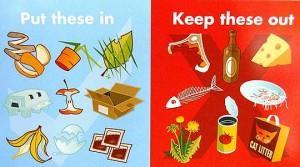 Have you ever looked in a compost bin at a restaurant or cafe? Though it’s not the most glamorous of tasks, I don’t mind digging through trash. I’d even offer that it’s one of my favorite pastimes. And, well, sometimes you have to–like when there’s a coffee cup lid or plastic wrapper just sitting there in compost bin, threatening to contaminate the whole operation. Because it will. And so will foil, yogurt cups, and sugar packets. Or maybe those are okay? Composting isn’t complicated, but it’s not the simplest thing either.
Have you ever looked in a compost bin at a restaurant or cafe? Though it’s not the most glamorous of tasks, I don’t mind digging through trash. I’d even offer that it’s one of my favorite pastimes. And, well, sometimes you have to–like when there’s a coffee cup lid or plastic wrapper just sitting there in compost bin, threatening to contaminate the whole operation. Because it will. And so will foil, yogurt cups, and sugar packets. Or maybe those are okay? Composting isn’t complicated, but it’s not the simplest thing either.
San Francisco mandated curbside compost collection in 2009 and since then it’s been a resounding success. The city estimates that it diverts 80% of all waste from landfills, and that composting collection has increased by more than 50% since 2010. There’s no doubting that New York can also succeed when it launches its own composting program in 2016. But while some Californians would argue that composting is in their DNA, it likely isn’t. And if it’s not in a Californian’s DNA, it’s probably not in the DNA of New Yorkers either.
How do you teach the do’s and don’ts of compost?
In addition to the many years of efforts to teach people to source-separate their food scraps for composting by cities like San Francisco, colleges and universities all across the country have started compost programs– and with it have compiled a whole list of best practices. One of the biggest takeaways is that if you want non-contaminated compost, it comes down to good signage and what I affectionately refer to as “compost-concierges.”
Colleges and universities that have started composting programs are careful to make detailed signage that lists exactly what can or cannot be placed in the compost bin—going so far as to inventory the items in a school cafeteria or restaurant and explicitly list on the signs what goes in what bin. They also employ “compost-concierges,” i.e. students who love trash so much they are willing to monitor (read: defend) compost bins during high trash times. While this may seem like overkill, I’ve served many a shift as a “compost-concierge” and, trust me, it is not innate which bin the wooden coffee stirrer goes in.
The fact is, for many people, composting is an entirely new phenomenon. An entirely new, awesome phenomenon that they’re more than willing to embrace, and often do, just not always 100% correctly. And as great as it is that individuals and cities are starting to think beyond cooking and buying food responsibly to considering how to discard food responsibly as well, an effective compost program is really reliant on an effective, informed consumer. The majority of the restaurants and cafés I’ve been to in the San Francisco area don’t rely on signs to help their customers navigate the semi-complicated world that is composting. In an ideal world we would learn about composting in elementary school, along with the unit on recycling. But for those of us for whom elementary school happened long ago, a little education could go a long way into ensuring the perfect compost.
Kristen Watkins, the Sustainability Program Specialist at Recology, a company in San Francisco that provides collection, recycling, compost and disposal services, informed me that Recology and the City of San Francisco staff put in a lot of effort to educate customers about using the composting bin. The City’s Department of the Environment spends significant amounts of time in San Francisco neighborhoods reaching out to residents and businesses alike to help them learn how San Francisco’s composting program works. Recology also has checks at the transfer station and compost facilities to ensure that the material used to make compost is free of any contaminants.
Watkins continued to point out that a lot of what can and cannot be composted (and recycled, for that matter) actually varies by city, depending on what the composting facility is setup to handle and what the city government advocates for. Recycle Ann Arbor, for example, can’t handle greasy pizza boxes or colored paper, but San Francisco has no problem composting these. Watkins also pointed out that San Francisco’s Department of the Environment has led an extensive outreach and education campaign and that Recology’s truck drivers are even in on it, helping their customers learn the do’s and don’t of what goes in the compost bin. Still, Watkins pointed out that if this whole endeavor is going to work, it’s important to explain more than what is accepted in the program; it’s also necessary to get at the why of composting– the circle of life, good for the earth, thing.
Education is a key component of making composting work. Many people are eager to compost- but we shouldn’t overestimate their ability to do so. A little education- a sign, a concierge, and maybe, one day, a mass media campaign- can do a lot to make sure this whole endeavor doesn’t go to waste.




